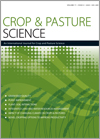Yield instability is a major issue in faba bean and is driven by plant traits and biotic and abiotic stresses. The present article reviews the main factors affecting plant yield, the most important yield components, the effect of environmental stresses (particularly low-temperature stress), and the role of sowing date in improving adaptation and yield in faba bean.

Crop and Pasture Science
Volume 71 Number 4 2020
Zinc (Zn) application to the wheat crop effectively improved the crop performance and grain quality of the following rice crop in conventional and conservation tillage systems. However, the conservation system involving direct-seeded aerobic rice, no-tillage wheat and soil-applied Zn led to improved soil health, and to increased grain harvest and better grain quality.
CP19560Combination of traits at two developmental stages under salt stress as a measure of tolerance in a reciprocally crossed rice (Oryza sativa) population

Success in breeding for salt tolerance is still limited owing to the complex nature of the trait, spread over multiple regions of the genome. This study of a reciprocal population between salt-tolerant and high-yielding rice varieties sheds light on many interesting aspects of trait choice at an early growth stage and selection for combinations of traits. These concepts should be very helpful in molecular breeding for salt tolerance.
CP19429Morpho-physiological adaptation and DNA methylation of wheat seedlings under osmotic stress

In this research, morpho-physiological characters and DNA methylation were used to study the responses of two wheat cultivars to osmotic stress. Two wheat cultivars differed in root development and leaf growth under osmotic stress, and AK58 showed significant changes in degree of methylation, which could help to reveal molecular mechanism of wheat adapting to osmotic stress from the perspective of epigenetics.
CP19435Molecular mapping of a novel early leaf-senescence gene Els2 in common wheat by SNP genotyping arrays
Early leaf senescence is one of the limiting factors for developing high yield potential in wheat. We report the first case of early leaf senescence in wheat controlled by a single incomplete-dominant gene. This novel early leaf-senescence mutant was characterised through phenotypic evaluation, physiological and biochemical analyses, and preliminary mapping to provide a foundation for fine mapping and map-based cloning of the mutant gene Els2.
The reaction rate of limestone in ameliorating soil acidity and its subsequent residual value influences its commercial attractiveness to growers. Limestone took up to 3 years to react over the range of common application rates (2.5–5 t/ha) but benefits to grain yield persisted for eight growing seasons. Over 7 years, coarser particle sizes of limestone (0.075–1 mm) only increased pH at about the same rate as the underlying soil acidification rate, resulting in little change in soil pH, and these coarse particles were apparently poorly distributed through the soil volume.
CP19296Spatial and temporal patterns of lodging in grain sorghum (Sorghum bicolor) in Australia
Lodging often occurs in sorghum in Australia owing to water limitation; however, no published study has quantified lodging occurrence. Our study revealed that lodging frequency and severity varied geographically and seasonally, that lodging frequency was associated with the SOI, and that lodging resistance has not improved in commercial hybrids over 14 years. This is the first study to document lodging occurrence in Australia and provides a more thorough understanding of the causes of this potentially devastating and intractable trait.
Concentrations of alkaloid toxins gramine, hordenine, DMT and 5-MeO DMT generally decrease over time during pasture growth, and alkaloid production is influenced predominately by heat and moisture stress. Tryptamine alkaloids are potentially significant contributors to phalaris SDN toxicity, whereas β-carboline was not detected in any phalaris plants. No specific known alkaloids were associated with staggers, but staggers may be caused by a synergistic effect.
CP19324Proximal sensing of Urochloa grasses increases selection accuracy
Extensive areas in the tropics are dedicated to livestock production; however, grazing activities in these areas are highly restricted by forage availability. By using sensors in place of conventional methods of forage evaluation, a larger number of forages can be reliably evaluated while incurring minimal additional cost. The use of digital cameras and hyperspectral sensors to evaluate forage characteristics and production was found effective and potentially useful for selecting outstanding hybrids.



